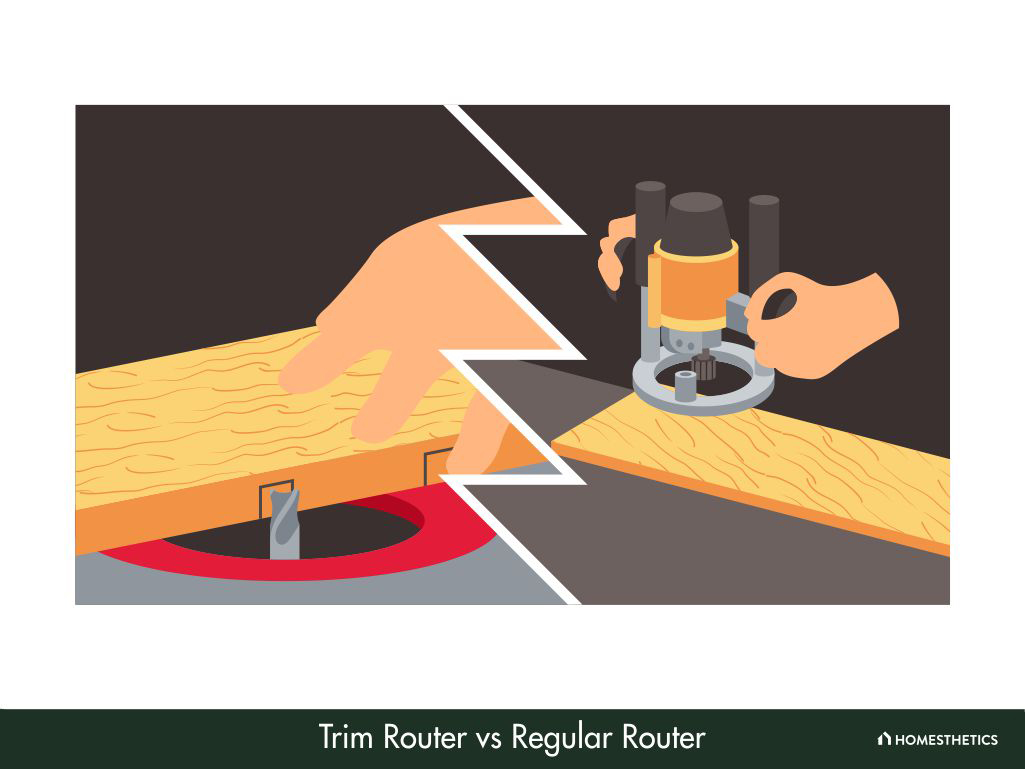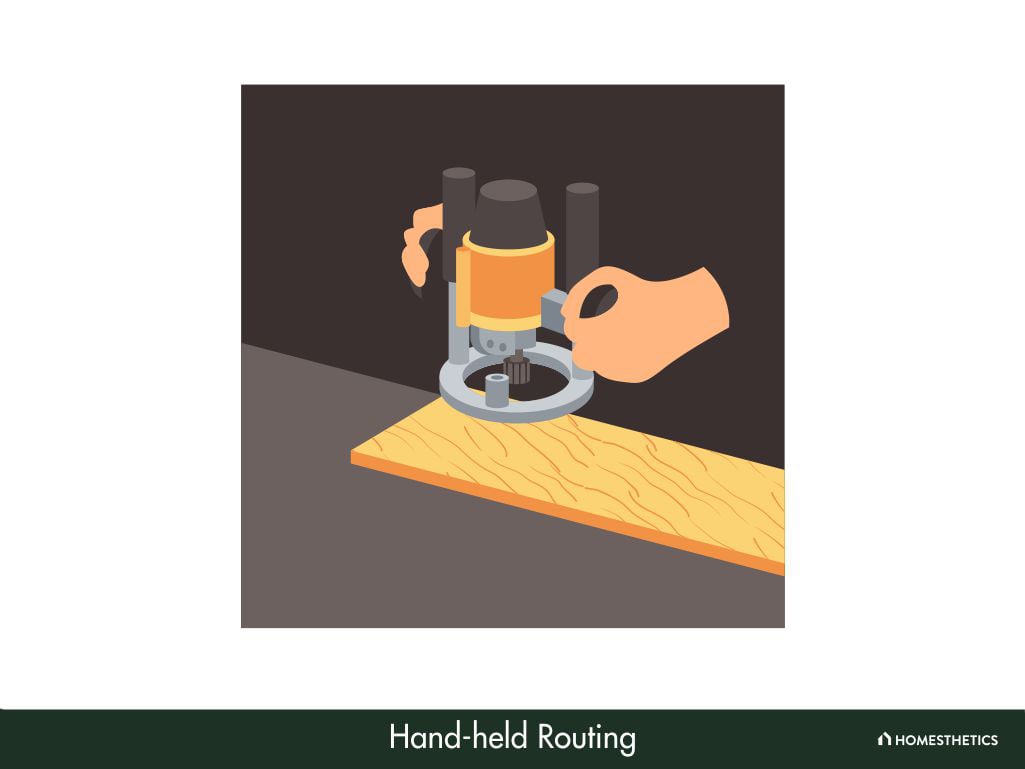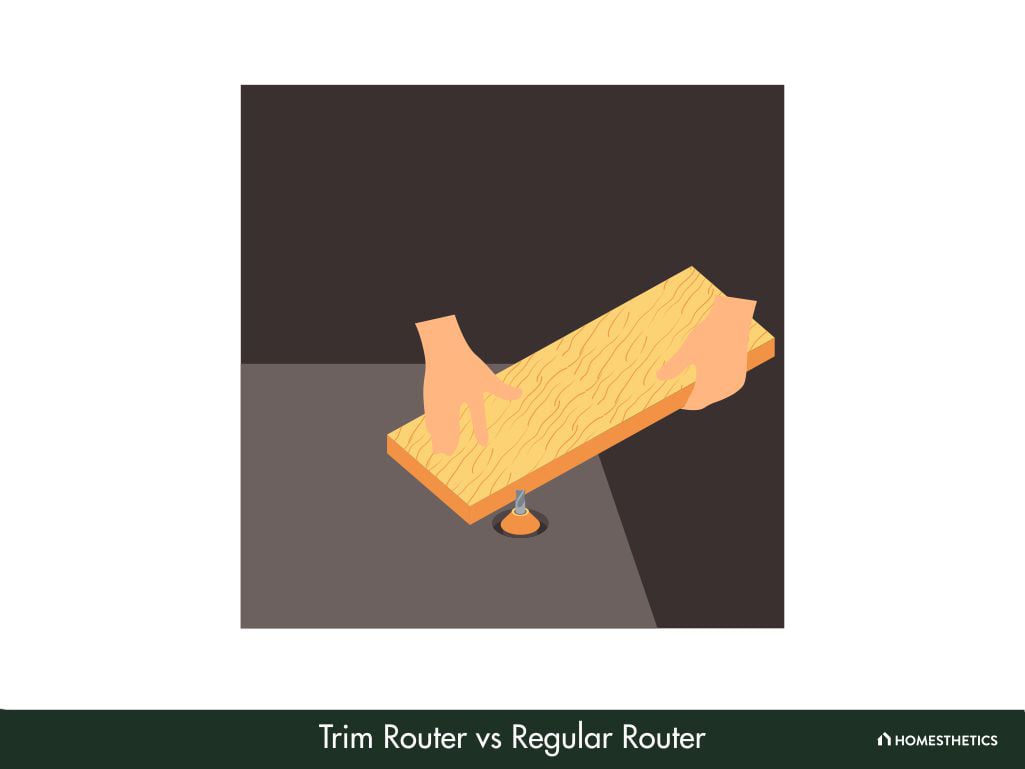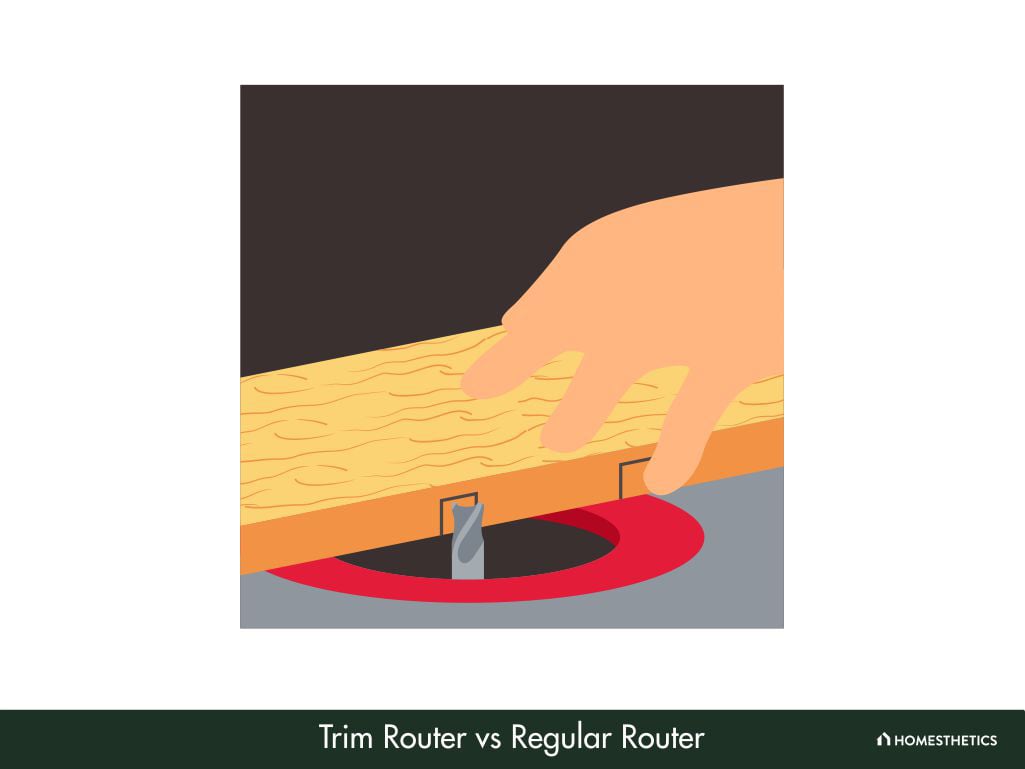Trim routers and regular routers are essential tools in every woodworker’s arsenal as a trim router is more suitable for smaller projects and intricate work, while a regular router is ideal for heavy-duty routing tasks. The clear winner as the “best” router of the two depends on your use case and expertise.

A woodworking router is a versatile tool that can help you make intricate designs, precise cuts, and unique shapes on wood.
These tools are commonly used by woodworkers and carpenters to create decorative edges, cut dadoes and grooves, and create intricate inlays. However, with so many different router types, choosing the right one for your work can be a challenging task.
Hence, in this comparative guide, I have explained the difference between the two popular types of routers - trim routers and regular routers. For better understanding of the information, I’ve also listed the pros and cons of each, so make sure you read till the end.
What is a trim router?
A trim router (or a laminate trimmer) is a handheld woodworking tool designed for precision trimming and shaping wood. It is also used to trim laminate like Formica. These tools are typically smaller and more lightweight than regular routers, making them easy to handle and operate with one hand.
Moving on, a trim router is ideal for a range of projects, such as trimming laminate or wood veneer, routing small grooves, and more. They are also ideal for working on small, intricate projects that require precision and finesse, such as creating dovetail joints or decorative inlays.
Additionally, a trim router comes in handy for trimming corners and making detailed cuts in small workpieces. This makes them a versatile tool for any novice woodworker or DIY enthusiast.
What is a plunge router?

A regular router (or a plunge router) is a powerful woodworking tool used for cutting, shaping, and trimming wood, plastic, and other materials. Regular routers have a larger motor and are designed to handle heavy-duty routing tasks. They are available in both handheld and table-mounted versions.
Moreover, standard routers are ideal for a wide range of projects, including cutting a dado, shaping a decorative edge, and making joinery cuts. They are also useful for carving, engraving, and curved-edge cutting.
Owing to their large size and motor, you could employ plunge routers for large-scale projects like house renovations, door construction, and cabinet making.
Trim router vs regular router - Different features

The primary distinction between trim routers and regular routers is the size. A trim router is essentially a more compact and lightweight version of a standard router that can be held with a single hand. However, there are some more functional differences between the two tools.
1. Output
Trim routers have a smaller motor, resulting in less power output. On average, trim routers have between ¾ and one horsepower, while regular routers typically have between 1 and 3 horsepower.
Because of the smaller output, trim routers may not accommodate larger bits like regular routers. Instead, they feature a guide bearing to prevent scratches on the material being worked on, particularly with lamination, which is susceptible to damage.
2. Trimming laminate
Using a trim router on laminate reduces the risk of damaging the material and consequently wasting it. This is because while a regular router employs a router bit, a trim router employs a guide bearing that safeguards the laminate from scratches.
3. Portability
Another benefit of trim routers over regular routers is the increased portability, as they are typically intended for single-handed use. Due to this, you can hold a trim router while holding down the material with one hand. This is particularly important when performing complex tasks like profiling edges.
Moreover, the compact size enhances convenience when working in remote locations and frequently trimming material.
4. Price
A trim router is also less expensive while being more adept at producing intricate and angled cuts, rendering it an ideal tool for trimming corners.
However, despite its functional advantages over a regular router, a trim router does have certain limitations. For example, its small motor means it is typically not well-suited for heavy-duty routing activities. Plus, a trim router lacks the numerous optional accessories that are often available on purchasing regular routers.
Pros of trim routers
1. Precision
Trim routers are very precise, making them ideal for a small, detailed workpiece. They are especially useful for creating intricate designs or patterns in woodwork.
2. Usability
A single trim router can be employed for a wide range of tasks, like trimming and shaping wood, cutting slots and grooves, etc. This versatility makes them a valuable addition to any woodworking toolkit.
3. Ease of use
A trim router is easy to set up and use, even for beginners. It features simple controls and is compatible with a variety of router bits, making it ideal for achieving different effects.
4. Cost-effective
Compared to other routers, a trim or fixed base router is generally less expensive, so I highly recommend it to DIY enthusiasts and hobbyists.
5. Portability
Owing to the small and lightweight build of a trim router, it is easy to carry on the go. This makes them ideal for working on projects outside of the workshop or for taking on the road.
6. Maneuverability
Adding to the previous point, a trim router is quite easy to handle and control. This factor is beneficial for beginners, especially when working with small or delicate wood pieces.
Cons of trim routers
Despite the multiple advantages of using a trim router, this tool is not devoid of drawbacks, which are as follows:
1. Limited size
The small size of a trim router, albeit a major advantage, can cause limitations in some cases. For instance, it is not suitable for making a large cut or working on larger wood pieces. That’s when a large plunge router will be more suitable.
2. Limited depth of cut
A trim router has a limited depth of cut, which means they are not ideal for making deep cuts or grooves. This can be a limitation when working with thicker wood pieces or when making certain types of joints.
3. Noise
A trim router is quite noisy, which is obviously a nuisance if you’re working in a shared space or if you’re sensitive to loud noises.
4. Vibrations
Like any power tool, a trim router can produce vibrations that can make it uncomfortable to use for extended periods of time. This can also affect the quality of your cuts if you are not careful.
5. Safety concerns
There’s always a risk of injury with power tools, and a trim router is no different. So, it is important to read the instructions carefully and take all necessary safety precautions, like wearing protective gear, using tools only as intended, etc.
6. Limited power
Trim routers are generally less powerful than larger plunge routers. This can make them less effective when working with harder materials or when making larger cuts.

Pros of regular routers
The advantages of a regular router or a plunge router are given below:
1. Size
A full-size plunge router sports a larger base, and hence, it is more stable than a trim router. This makes them easy to control when making cuts. It also features larger handles, which can make it more comfortable to use for extended periods of time.
2. Accessories
Unlike a trim router, a plunge router features multiple accessories, such as router tables, which make it even more versatile and easier to use. These accessories can help to increase precision and accuracy when making cuts.
Tip
Employing the accessories incorrectly may also cause accidents, so always ensure that you’re using the right size and type of accessories.
3. Power
A full-size plunge router offers more power than a trim router. This makes the former ideal for working with harder materials and making larger cuts. Plus, this factor is especially beneficial for professional woodworkers who need to work with a variety of materials and make precise cuts.
4. Versatility
As mentioned previously, a regular router can be used with a wide variety of router bits, which makes the tool a lot more versatile than a trim router.
5. Efficiency
A regular router is generally faster and more efficient than trim and fixed base routers, thereby being suitable for larger projects or professional use.
6. Depth of Cut
A regular router can cut deeper than a trim or fixed base router, so the former is more suited for making larger grooves and cuts. For this reason, I stick to a regular router for making joints or working with thicker pieces of wood.
Cons of regular routers
Some potential disadvantages of a regular router are as follows:
1. Safety concerns
There is always a risk of injury involved when using a full-sized regular router since it’s more dangerous than a trim router. Hence, it is imperative to take all necessary safety precautions during use.
2. Learning curve
Using a plunge-base router is more difficult to learn than a trim router. They require more skill and experience to operate properly and safely, which can be a disadvantage for beginners or those who are not familiar with woodworking.
3. Noise and vibration
A standard plunge router can be quite noisy, especially when used at high speed, and cause a lot of vibrations, which can be uncomfortable to work with for extended periods of time. This can also affect the quality of your cuts if you are not careful.
4. Maintenance
Compared to a compact router, a full-sized one can require more maintenance, which includes regular cleaning and lubrication. This can be a disadvantage for those who do not have the time or knowledge to perform these tasks.
5. Cost
Despite being a handy tool, a regular router base is generally more expensive, which can be a disadvantage for hobbyists or DIYers who are on a budget.
6. Size and weight
A plunge-base router is larger and heavier than a trim router, which can make it more difficult to maneuver and control. This can be especially true for beginners or for those who are working on delicate or intricate projects.
What safety precautions should you take when using a trim router or a regular router?
Below are some safety precautions should you take when using a trim router or a regular router.
A. Wear eye and ear protection
Routers can generate a lot of dust and noise, which can be harmful to your eyes and ears. Wear safety glasses and earplugs or earmuffs to protect yourself.
B. Use a dust mask
Breathing in wood dust is hazardous to health. So, always wear a dust mask or respirator to avoid inhaling unwanted particles.
C. Use proper clothing
Avoid wearing loose clothing, jewelry, or anything that could get caught in the router. Try wearing tight-fitting clothing, and tying back long hair.
D. Keep your workspace clean and organized
Ensure that your workspace is free from any tripping hazards and clutter to avoid mishaps.
E. Use a secure and flat surface
Make sure your router is securely mounted on a stable work surface, such as a router table or bench. This will help prevent the router from tipping or moving during use.
F. Use a suitable router bit
Only use a router bit that is specifically designed for the type of cut you need. Also, make sure the bit is properly installed and tightened before use.
G. Use the router with both hands
When using the router, keep both hands on the tool, with one on the handle and the other on the base. This will help you maintain control and stability while using the router.
H. Turn off the router when not in use
Once you’re done using the router, turn it off and unplug it from the power source. Also, keep it out of reach of children.
For woodworking, choosing the right tool for the specific job is crucial. While both trim routers and regular routers have their pros and cons, consider choosing one that best suits your needs and budget.
After putting each router test, I believe that a trim router is the best for beginners working on smaller projects. On the other hand, if you are a professional or working on larger projects, a regular router may be the better option.
But whatever you choose, be sure to follow all the safety precautions mentioned above and use the tool properly to achieve the best result.
